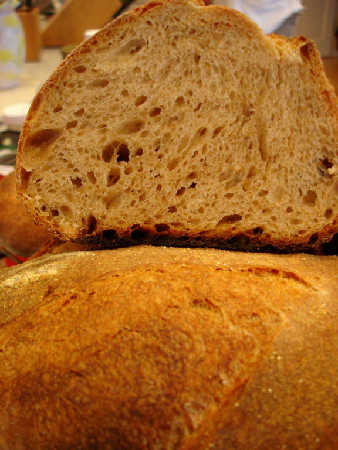
Time for pizza
Hi Mariana, and of course to anyone else that wants to join in…the more the merrier!
I must say that I've tried many pizza dough recipes in the past but I think I've finished looking for the best – I found it. Again Rose shines, and it is her " Perfect pizza dough" recipe on pg 189 in the Bread Bible. I used to get left over crusts all the time, but not any more. The all purpose flour and light handed mixing keep it very tender, and also very easy to make. The kids sometimes eat it cold and they still finish the crusts.
I always let the dough rest overnight in the fridge, and since it is so hot in the summer I put it straight away in the fridge right after mixing without waiting the 30 min. as per instructions.
As for tinkering…the first time I made it as written and hubby said he thought it was a bit too salty, so I cut that a bit, then I figured I could cut the sugar as well, and in the summer I cut down on the yeast too. Sometimes I use wwflour in place of a portion of the all purpose. So in the end this is quite a deviation from the original but as I said before I really think the tender texture comes from the AP flour and very little mixing, and doesn't really have so much to do with the exact recipe. For this to feed 6 people, and some of us have a big pizza appetite, I multiply the recipe by 5.
Instead of measuring the oil, I just coat the inside of the rising container with olive oil making sure to cover the dough as well.
When it has risen I divide the dough and round each piece coating slightly with the oil and put them straight away on baking parchment. Now I know it's not professional, but I roll out the dough – the flinging in the air stuff doesn't work for me, and just flattening out with my hands makes the crust too thick, so I roll, rest, roll, rest, roll etc on the paper, until it is thin enough, . Then let the dough rise until it is puffy. In winter it takes about 45 min- 1 hr, in summer about 30 min.
Then go on the sauce and toppings and cheese. Everyone has their favourites but I don't cook the tomato sauce and most of the toppings (like onions, mushrooms) are raw, but sliced very thinly.
Now for the interesting part – the oven. I really love my oven (Scholtes – it's a French make). I got it a few years ago because it had a special program for baking yeast dough that keeps the oven very moist, and uses more bottom heat than top to allow the dough to continue rising during oven spring. There are also many automatic programs and one of them is for pizza. So here goes : this gives me a fully baked large pizza in 4 minutes. With a bit of monitoring I'm sure it can be done with most modern ovens. First of all preheat the pizza / baking stone on the rack on the second to the highest position in your oven. Since this is an automatic program, the oven doesn't state the temp but I'm sure it's very hot. Then slide the pizza with the baking paper onto the stone and bake for 3 min. (After the first 1 - 2 min. you can remove the paper if you like.) Then switch the oven setting to "broil" and stay close by, as this will take only about 1 min before it's ready. After removing the pizza, give the oven a few minutes to reheat before baking the next one. The timing works out well, so we usually just finish eating one by the time the next one is ready.
So that's my pizza story. Please feel free to ask about anything that isn't clear. Enjoy your pizzas everyone!
Please excuse my computer...I wrote this in 'word' and then copied and pasted it here, but obviously the hebrew default setting is effecting the way it comes out and everything is lined up on the wrong side. Sorry about that -hope you can still understand it. (ed. note: I fixed it for you)



 Reinhart's WGB multi-grain Struan
Reinhart's WGB multi-grain Struan  Reinhart WGB: Multi-grain Struan crumb
Reinhart WGB: Multi-grain Struan crumb Round Holiday Challah
Round Holiday Challah 




 Leader's Pain au levain
Leader's Pain au levain Leader's Auvergne Rye Baguette with pancetta
Leader's Auvergne Rye Baguette with pancetta  Leader's Pain au levain: crumb
Leader's Pain au levain: crumb Leader's Auvergne Rye Baguette with pancetta: crumb
Leader's Auvergne Rye Baguette with pancetta: crumb 
